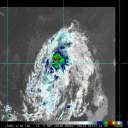Show Selection:
|
#904639 (Received by flhurricane at: 4:49 AM 26.Sep.2017)
TCDAT4
Hurricane Lee Discussion Number 33
NWS National Hurricane Center Miami FL AL142017
500 AM AST Tue Sep 26 2017
Lee's cloud pattern has continued to become better organized this
evening. The eye has cleared out and has warmed to nearly 10
degrees Celsius, and the eye wall cloud tops have cooled to
-63 degrees Celsius. The initial intensity is increased modestly to
85 kt and is based on a blend of the subjective and objective Dvorak
T-numbers. It is worth noting that the ADT adjusted raw T-number
yields an estimated intensity of 97 kt based on an eye scene-type.
The previously noted southeasterly shear undercutting the diffluent
flow aloft has certainly diminished and should remain low for the
next 48 hours or so. During this initial period, Lee could get a
little stronger as indicated in the HWRF hurricane model and the
Decay-SHIPS. Afterward, increasing vertical shear, primarily due to
the outflow generated by Maria, and decreasing sea surface
temperatures should induce a gradual weakening trend as the cyclone
moves into a high latitude baroclinic zone and ultimately becomes an
extratropical cyclone in 4 days. The intensity forecast is
basically an update of 6 hours ago, and follows an average of the
IVCN and Florida State Superensemble guidance.
The initial motion is estimated to be westward, or 260/9 kt. The
cyclone is expected to continue moving within the easterly mid-level
steering flow, produced by a relatively narrow mid-tropospheric
ridge situated to the north, during the next 24 hours. Afterward,
a combination of a broad mid- to upper-level shortwave trough moving
out of the eastern Canadian Provinces and a subtropical ridge
building east of Lee should steer the hurricane gradually
northwestward and northward. On day 3 and beyond, Lee is forecast
to accelerate northeastward as it becomes embedded in a deep-layer
high latitude southwesterly flow downstream from the aforementioned
shortwave trough. Global models and the Cyclone Phase Evolution
analysis/forecast product show Lee become a extratropical
cyclone no later than day 4. The NHC forecast track is a little
south of the previous one through 48 hours, but similar
thereafter, and is based on the TVCX and HCCA consensus models.
FORECAST POSITIONS AND MAX WINDS
INIT 26/0900Z 30.0N 52.5W 85 KT 100 MPH
12H 26/1800Z 29.9N 53.9W 90 KT 105 MPH
24H 27/0600Z 30.2N 55.4W 90 KT 105 MPH
36H 27/1800Z 30.9N 56.4W 90 KT 105 MPH
48H 28/0600Z 32.2N 56.6W 85 KT 100 MPH
72H 29/0600Z 36.9N 53.0W 75 KT 85 MPH
96H 30/0600Z 44.5N 40.2W 60 KT 70 MPH...POST-TROP/EXTRATROP
120H 01/0600Z 50.9N 22.0W 50 KT 60 MPH...POST-TROP/EXTRATROP
$$
Forecaster Roberts |



